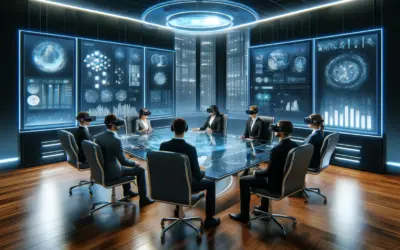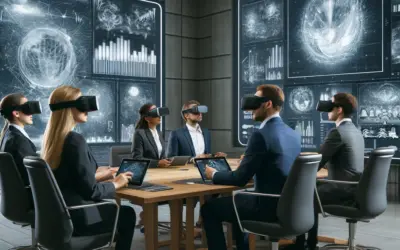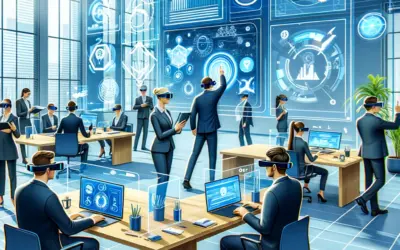As the digital age evolves, virtual reality (VR) meetings in the metaverse are becoming a fascinating reality. The metaverse, a term once coined by fiction, is now a virtual space where people can interact, work, and socialize in a 3D environment. With the integration of VR technology, metaverse meetings offer an immersive experience that goes beyond traditional video conferencing, enabling participants to feel as if they are in the same room, even when they are worlds apart.
The Seamless Integration of Virtual Reality With the Metaverse
Virtual reality adds a tactile dimension to the metaverse by allowing users to engage with the environment and with each other through avatars. This level of interaction is achieved by wearing a VR headset, which provides a 360-degree view of the virtual workspace. This integration of VR and the metaverse means that team collaboration and project management can occur in a more dynamic and engaging virtual setting. For businesses, this innovation heralds a new era of remote work and global connectivity.
Benefits of VR Meetings for Remote Collaboration
One of the astonishing advantages of VR meetings is the enhanced sense of presence. Unlike typical video calls, VR meetings in the metaverse allow individuals to read body language, make eye contact, and interact with objects or presentations as if they were physically together. This deepens the connection, encourages active participation, and improves the overall quality of communication. Additionally, the creative potential is limitless – imagine brainstorming sessions where you can literally draw ideas in the air or walkthrough architectural designs as if they were already built.
- Immersive Interaction: Real-time collaboration and tactile engagement.
- Global Reach: Connect with colleagues from anywhere in the world without travel.
- Enhanced Focus: Distraction-free environments tailored for productivity.
- Creative Freedom: Innovative presentation and communication tools.
How to Get Started with VR Meetings in the Metaverse
To begin exploring the wonders of VR meetings in the metaverse, businesses and individuals will need to invest in some basic equipment, typically a VR headset and, in some cases, motion tracking accessories. Once the hardware is set up, users can access various platforms designed for virtual meetings. These platforms offer a range of settings, from boardrooms to auditoriums, and can be customized to suit the need of any team or event. The key to successful adoption is to ensure that all participants are comfortable with the technology and provide training if necessary. As the technology continues to improve, it’s expected that VR meetings will become as commonplace as sending an email or making a phone call.
While the concept of VR meetings in the metaverse might sound futuristic, it’s an innovation that’s very much rooted in the present. By understanding and embracing this cutting-edge technology, businesses and individuals alike can unlock new realms of productivity, creativity, and global collaboration.
The Future of Collaboration: How the Metaverse Enhances Virtual Meetings
The Future of Collaboration: How the Metaverse Enhances Virtual Meetings
In recent years, virtual meetings have become the norm for businesses and teams across the globe. Yet, they frequently lack the engagement and connectivity of in-person interactions. As we step into the future, the Metaverse emerges as a game-changing platform, offering a rich, immersive experience that promises to redefine the landscape of virtual collaboration.
Immersive Environments Breaking Physical Boundaries
One defining feature of the Metaverse is its ability to create intricate and realistic environments. Participants in a virtual meeting can interact in a three-dimensional space that closely simulates the nuances of physical presence. Avatar representations allow for gestures and body language, far surpassing the capabilities of traditional video conferencing. This environment transcends geographical limitations and opens the door for more meaningful exchanges, as if all participants were gathered in a single room.
Enhanced Interactive Tools for Comprehensive Collaboration
Beyond replication of real-world interaction, the Metaverse introduces a variety of tools that can enhance collaboration. Virtual meetings in the Metaverse can include dynamic elements such as live polls, interactive whiteboards, and even virtual prototypes for examination. These tools are not just novelties; they represent a significant leap in how we share information and ideas, boosting retention and participation significantly.
Building Communities Beyond the Boardroom
Virtual meetings within the Metaverse also offer the opportunity to build a sense of community and camaraderie. Unlike the typical video call, where participants may feel isolated behind screens, the Metaverse provides shared virtual experiences that can forge stronger connections amongst team members. Teams can collaborate not only on business tasks but also share social interactions in a virtual space, making the Metaverse a holistic platform for both work and play.
Essential Gear for Participating in Metaverse Virtual Reality Meetings
Essential Gear for Participating in Metaverse Virtual Reality Meetings
As the world pivots to increasingly immersive online interactions, participating in Metaverse virtual reality meetings has become the new frontier of remote communication. To ensure an optimal experience, having the right gear is vital. In this blog post, we will explore the essential equipment required to dive into virtual reality meetings effectively.
High-Performance VR Headset
The cornerstone of any virtual reality experience is a high-performance VR headset. The market boasts several options, ranging from entry-level models to high-end systems. Key features to look for include high-resolution displays, comfortable fit, a wide field of view, and integrated audio. Some of the top-rated headsets conducive for professional use in the Metaverse include the Oculus Quest 2, HTC Vive Pro, and Valve Index. Whichever model you choose, it should cater to prolonged usage with minimum discomfort and maximum sensory immersion.
Reliable Motion Tracking Accessories
Motion tracking devices translate your real-world movements into the virtual space with precision. These accessories, such as controllers and sensors, increase interactivity, allowing for gestures and body language to be part of your virtual presence. Advanced controllers with haptic feedback can enhance the experience by providing tactile responses, simulating touch and pressure. To facilitate a full range of motion without obstructions, consider wireless options or a tether management system.
Comfortable Wearables
Comfort is paramount in virtual meetings that can span several hours. This is where comfortable wearables come into play, helping you stay focused on the content of the meeting rather than any physical discomfort. Look for gear like cushioned headset padding, adjustable straps, and breathable materials. Additionally, wearable technology such as VR gloves can further bridge the gap between virtual and physical interactions by enabling natural hand movements and finger tracking.
Powerful Computing Hardware
Last but certainly not least, to handle the demands of high-quality VR software, you’ll need powerful computing hardware. Gaming PCs or laptops with robust graphics cards, fast processors, ample RAM, and plenty of storage are pre-requisites for a smooth virtual meeting experience. These specifications are crucial to avoid lag, guaranteeing that your avatar mirrors your actions in real-time and minimizes motion sickness, providing a seamless integration into the Metaverse.
Maximizing Productivity in Metaverse Meetings: Tips and Best Practices
Maximizing Productivity in Metaverse Meetings: Tips and Best Practices
In the burgeoning world of virtual reality, the Metaverse offers innovative avenues for collaboration and meetings. However, maintaining productivity within this dynamic space can be challenging. Here’s how to harness the vast potential of Metaverse meetings while ensuring your team’s productivity soars.
Pre-Meeting Preparations
Prioritizing pre-meeting preparations is crucial for productive Metaverse meetings. When each participant is well-prepared, meetings become streamlined and efficiently run through defined agendas. Here are steps to prepare effectively:
- Set Clear Objectives: Establish goals to focus the meeting and provide direction.
- Distribute Agendas: Share topics and materials beforehand so attendees can prepare questions and input.
- Technical Check: Ensure all participants have compatible hardware and a stable internet connection to avoid mid-meeting technical issues.
In-Meeting Engagement Strategies
Keeping participants engaged is a unique challenge in a virtual environment. Utilize the Metaverse’s interactivity with these strategies:
- Interactive Elements: Incorporate polls, quizzes, or digital whiteboards to foster active participation.
- Clear Communication: Encourage everyone to be clear and concise, reducing meeting time and confusion.
- Regular Breaks: Schedule short breaks to combat virtual fatigue and maintain focus.
Post-Meeting Follow-up
Once your Metaverse meeting concludes, it’s vital to ensure that insights and tasks don’t get lost in the virtual ether. Effective follow-up solidifies productivity gains:
- Meeting Minutes: Distribute a concise summary of discussions, decisions, and assigned tasks.
- Action Plan: Define clear next steps and deadlines for participants to drive accountability.
- Feedback Loop: Gather feedback on the meeting’s effectiveness to improve future sessions.
By integrating these tips and best practices into your Metaverse meetings, you can transform them into powerhouses of productivity. Embrace the future of collaborative work by fine-tuning your approach to virtual gatherings and watch as your team’s efficiency and cohesion reach new heights.
Overcoming Challenges and Addressing Privacy in Metaverse VR Meetings
Enhancing User Experience
Another crucial challenge is the user experience. For many, venturing into VR is a novel experience, which can come with a steep learning curve. To make this transition smoother:
- Offer tutorials on how to use the controls and navigate the virtual environment.
- Implement intuitive interfaces that mimic real-life interactions.
- Promote a code of conduct to foster a respectful and inclusive virtual space.
Ensuring Effective Communication
Furthermore, clear communication is the backbone of any successful meeting. Within VR, vocal cues and body language can be redefined. To ensure messages are conveyed effectively:
- Encourage the use of avatars that represent participants’ gestures and facial expressions accurately.
- Facilitate spatial audio technology that allows for natural conversation flow and directionality.
- Optimize virtual meeting rooms for acoustics, minimizing audio disturbances and interruptions.
Addressing Privacy in Metaverse VR Meetings
Privacy in Metaverse VR meetings is a paramount concern. Sensitive information must be guarded fiercely against any form of eavesdropping or data breaches. To address this concern, strong, end-to-end encryption is vital for all communications. This not only secures conversations but also protects shared digital documents and user data.
Implementing Access Control and Authentication Measures
Control over who can enter virtual spaces is a critical step towards a secure environment. This can be achieved through:
- Multifactor authentication (MFA), ensuring only authorized participants join meetings.
- Advanced permission settings, allowing hosts to control room entry and participant privileges.
Providing Transparency and Control to Users
All users should be provided with transparent information about how their data is collected and used. Additionally:
- Offering personal privacy settings within the Metaverse allows users to manage their own data and level of interaction.
- Developing straightforward data policies and obtaining explicit user consent for any data capture is necessary.
The onus of responsibility also falls on users to maintain privacy. They should be educated about best practices, such as securing their hardware and being cautious of sharing personal information within VR spaces. As the Metaverse expands, consistent efforts from both developers and users will be key to overcoming challenges and ensuring privacy in VR meetings.













0 comentarios